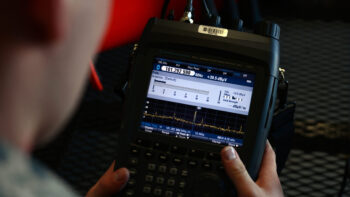
London: French air forces flying strike missions in Libya against Gaddafi’s loyalists are not using detailed imagery and intelligence provided by US airborne surveillance aircraft, according to statements made today by French pilots involved in those sorties.
Since the first day of NATO air strikes in Libya, French combat air crews have been struggling to positively identify ‘what or whom’ they were targeting, a serving French pilot told an audience of defense industry and military aviators attending a London conference. ‘The pilot in the kill box was entirely on his own’.
When asked why French air forces were not taking advantage of advanced manned and unmanned targeting imagery, pilots responded that it took too much time to coordinate with NATO commanders at the Combined Air Operations Center (CAOC) in northern Italy. Instead, pilots deferred to using their own reconnaissance pods. Pilots reported rejecting Predator drone images for targeting purposes, saying its imagery took too long to get cleared through the CAOC.
The French pilots also said they preferred imagery from their own pods as they had embedded kill squares on them. They would typically launch a reconnaissance plane, snap photos, identify targets and have another strike aircraft inbound to the target within five hours.
French aircrews also emphasized the constant concern of avoiding air strikes on civilians and spoke about the difficulty of positively identifying targets on the ground without the help of trained ground controllers. No NATO country has committed ground troops to the conflict.
The US Department of Defense refused to comment on the French Navy’s statement or on French air strikes in Libya.
All this stands in contrast to statements made by French Air Force General Stephane Abrial, commander of NATO’s allied command transformation: ‘We could not have performed to the same level of effectiveness [in Libya] without heavy contribution from the U.S.’ The General said this particularly applied to targeting.
Since March, France has led NATO partners, including the US, in the number of strike sorties since Operation Unified Protector began: 33% or 2,225 sorties by 4 August. After the initial stages of the air campaign, US forces under then Secretary of Defense Robert Gates withdrew from many strike missions to assume a support role within NATO. The Pentagon has likewise emphasised that ‘US forces are playing a constrained and supporting role in a multinational coalition’. To date, however, US expenditures on Libyan operations are expected to surmount $1bn by the end of September. France estimates its cost at 320m euros to date; UK costs are currently estimated at £260m.
Though US forces are carrying out fewer strike sorties, the expense of supporting NATO operations through surveillance and reconnaissance flights continue to escalate. Fourth-fifths of ‘intelligence and surveillance’ flights – manned or unmanned – in Libya have been flown by the US and these, along with aerial refuelling missions, have racked up some 23,500 sorties – the most of any country, including France.
These intelligence and surveillance flights have been conducted by a wide range of hi-tech American airborne technologies, including the U-2 spy plane, E-8 JSTARS, the Navy’s EP-3 and EA-18G Growler, the Air Force’s EC-130H Compass Call, as well as unmanned aerial vehicles like Reaper and Predator.
Robert Densmore is a London-based defense reporter.
Australia unveils ‘historic’ defense boost to 2.4% of GDP in decade, but critics say too little, too late
Part of the shakeup includes tens of billions for nuclear-powered subs, and halting the pricey procurement of an additional F-35 fighter jet squadron.



























